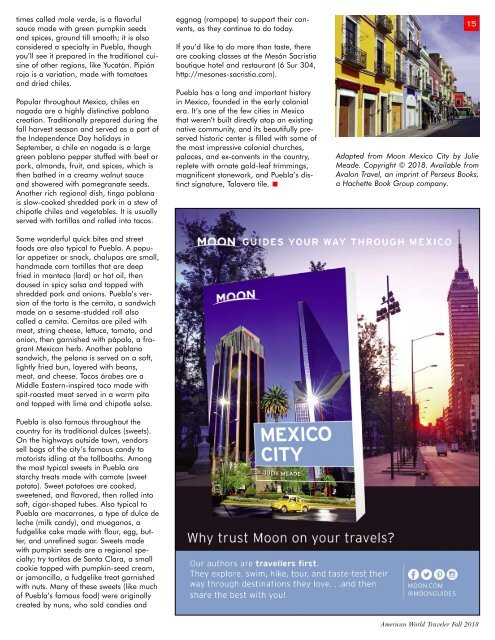American World Traveler Fall 2018 Issue
Now in our 16th year of publishing, American World Traveler explores the culture and history of worldwide destinations, sharing the adventure of discovery with our readers and motivating them to make their travel dreams a reality. Published quarterly, AWT helps sophisticated, independent American travelers choose their next destination by offering a lively blend of intelligent, informative articles and tantalizing photographic images from our World’s best destinations, cruises, accommodations and activities to suit every traveler's taste.
Now in our 16th year of publishing, American World Traveler explores the culture and history of worldwide destinations, sharing the adventure of discovery with our readers and motivating them to make their travel dreams a reality. Published quarterly, AWT helps sophisticated, independent American travelers choose their next destination by offering a lively blend of intelligent, informative articles and tantalizing photographic images from our World’s best destinations, cruises, accommodations and activities to suit every traveler's taste.
Create successful ePaper yourself
Turn your PDF publications into a flip-book with our unique Google optimized e-Paper software.
times called mole verde, is a flavorful<br />
sauce made with green pumpkin seeds<br />
and spices, ground till smooth; it is also<br />
considered a specialty in Puebla, though<br />
you’ll see it prepared in the traditional cuisine<br />
of other regions, like Yucatán. Pipián<br />
rojo is a variation, made with tomatoes<br />
and dried chiles.<br />
Popular throughout Mexico, chiles en<br />
nogada are a highly distinctive poblano<br />
creation. Traditionally prepared during the<br />
fall harvest season and served as a part of<br />
the Independence Day holidays in<br />
September, a chile en nogada is a large<br />
green poblano pepper stuffed with beef or<br />
pork, almonds, fruit, and spices, which is<br />
then bathed in a creamy walnut sauce<br />
and showered with pomegranate seeds.<br />
Another rich regional dish, tinga poblana<br />
is slow-cooked shredded pork in a stew of<br />
chipotle chiles and vegetables. It is usually<br />
served with tortillas and rolled into tacos.<br />
Some wonderful quick bites and street<br />
foods are also typical to Puebla. A popular<br />
appetizer or snack, chalupas are small,<br />
handmade corn tortillas that are deep<br />
fried in manteca (lard) or hot oil, then<br />
doused in spicy salsa and topped with<br />
shredded pork and onions. Puebla’s version<br />
of the torta is the cemita, a sandwich<br />
made on a sesame-studded roll also<br />
called a cemita. Cemitas are piled with<br />
meat, string cheese, lettuce, tomato, and<br />
onion, then garnished with pápalo, a fragrant<br />
Mexican herb. Another poblano<br />
sandwich, the pelona is served on a soft,<br />
lightly fried bun, layered with beans,<br />
meat, and cheese. Tacos árabes are a<br />
Middle Eastern-inspired taco made with<br />
spit-roasted meat served in a warm pita<br />
and topped with lime and chipotle salsa.<br />
Puebla is also famous throughout the<br />
country for its traditional dulces (sweets).<br />
On the highways outside town, vendors<br />
sell bags of the city’s famous candy to<br />
motorists idling at the tollbooths. Among<br />
the most typical sweets in Puebla are<br />
starchy treats made with camote (sweet<br />
potato). Sweet potatoes are cooked,<br />
sweetened, and flavored, then rolled into<br />
soft, cigar-shaped tubes. Also typical to<br />
Puebla are macarrones, a type of dulce de<br />
leche (milk candy), and mueganos, a<br />
fudgelike cake made with flour, egg, butter,<br />
and unrefined sugar. Sweets made<br />
with pumpkin seeds are a regional specialty;<br />
try tortitas de Santa Clara, a small<br />
cookie topped with pumpkin-seed cream,<br />
or jamoncillo, a fudgelike treat garnished<br />
with nuts. Many of these sweets (like much<br />
of Puebla’s famous food) were originally<br />
created by nuns, who sold candies and<br />
eggnog (rompope) to support their convents,<br />
as they continue to do today.<br />
If you’d like to do more than taste, there<br />
are cooking classes at the Mesón Sacristia<br />
boutique hotel and restaurant (6 Sur 304,<br />
http://mesones-sacristia.com).<br />
Puebla has a long and important history<br />
in Mexico, founded in the early colonial<br />
era. It’s one of the few cities in Mexico<br />
that weren’t built directly atop an existing<br />
native community, and its beautifully preserved<br />
historic center is filled with some of<br />
the most impressive colonial churches,<br />
palaces, and ex-convents in the country,<br />
replete with ornate gold-leaf trimmings,<br />
magnificent stonework, and Puebla’s distinct<br />
signature, Talavera tile.<br />
15<br />
Adapted from Moon Mexico City by Julie<br />
Meade. Copyright © <strong>2018</strong>. Available from<br />
Avalon Travel, an imprint of Perseus Books,<br />
a Hachette Book Group company.<br />
<strong>American</strong> <strong>World</strong> <strong>Traveler</strong> <strong>Fall</strong> <strong>2018</strong>
















